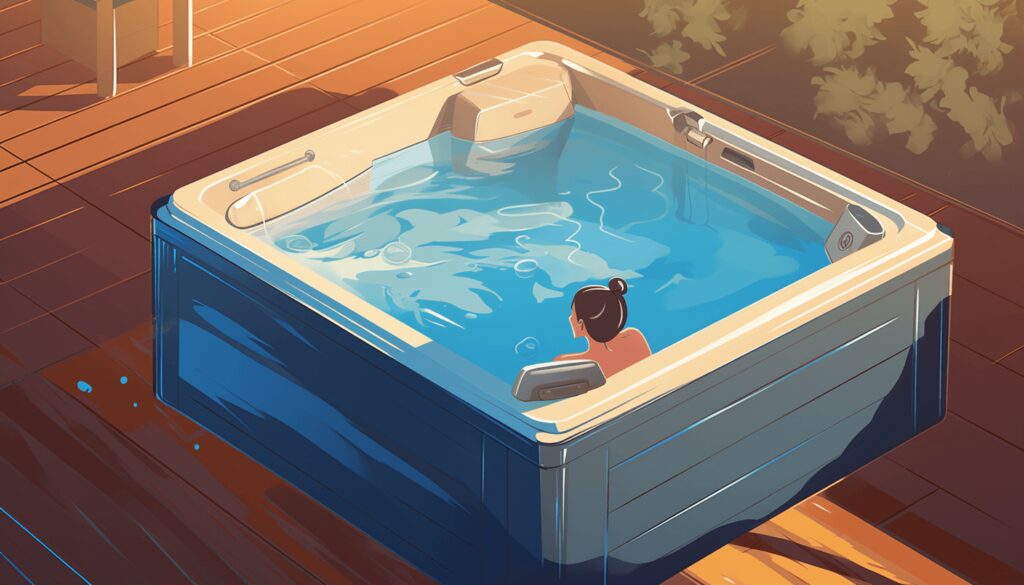Hot tubs are a popular way to unwind, relax muscles, and even alleviate certain types of pain. However, like many good things in life, moderation is key. Staying too long in a hot tub can turn a relaxing experience into a health risk.
This article provides a comprehensive guide on how long you can safely enjoy your time in a hot tub. We’ll delve into various factors influencing safe soak times, from water temperature to individual health conditions, to help you make the most out of your hot tub sessions without compromising your well-being.
The Basics: General Time Recommendations for Hot Tub Use
On average, a healthy adult can safely spend 15 to 30 minutes in a hot tub with a water temperature of around 100-102°F. However, this is a general guideline, and the safe duration can vary based on several factors. The water temperature is a significant determinant; the higher the temperature, the shorter your stay should be. For instance, if the water is at the maximum recommended temperature of 104°F, a soak longer than 15-20 minutes is not advised.
Individual health conditions also play a crucial role. People with certain medical conditions like heart issues or high blood pressure should consult their healthcare providers for personalized advice. Even your day’s activities, like whether you’ve exercised or consumed alcohol, can influence how long you should stay in the hot tub.
Understanding the Risks of Overuse
Exceeding the recommended time in a spa can lead to various health issues. The most immediate risks include dizziness and dehydration. Because hot tubs elevate your body temperature, staying too long can cause your body to overheat, leading to symptoms like light-headedness or fainting. Dehydration is another concern, as the hot water and steam can cause your body to lose fluids rapidly.
In more severe cases, prolonged exposure to hot water can lead to heat stroke, a serious condition that requires immediate medical attention. Symptoms of heat stroke include an accelerated heart rate, confusion, and even loss of consciousness. Overuse can also exacerbate existing health conditions, such as heart problems or high blood pressure. It is crucial to adhere to recommended soak times and consult a healthcare provider if you have pre-existing medical conditions.
Age-Specific Guidelines
Different age groups have varying tolerances and risks associated with hot tub use. For adults, the general guidelines mentioned earlier apply. However, seniors, especially those over 65, should consult their healthcare providers for personalized advice, as they may be more susceptible to heat-related issues. Children present another set of considerations. Kids aged 5 to 12 should only be allowed in the hot tub if the water temperature is set at 98°F or cooler, and their soak time should not exceed 5-10 minutes. Teens can generally follow adult guidelines but should start with shorter soak times to gauge their tolerance. Regardless of age, supervision is crucial to ensure safety for all users.
Health Conditions and Hot Tub Use
If you have pre-existing health conditions, it’s imperative to consult a healthcare provider before using a hot tub. Individuals with heart conditions, high blood pressure, or circulatory issues should get medical advice tailored to their situation. Pregnant women should also exercise caution; it’s generally advised to keep the water temperature at 101°F or below and limit soak times to 10 minutes. Those taking medications, especially anticoagulants or medications that cause drowsiness, should also consult their doctors. Even if you’ve received the green light from your healthcare provider, always monitor how you feel during your soak. If you experience discomfort or symptoms like dizziness or nausea, exit the hot tub immediately.
External Factors: Weather and Environment
Believe it or not, the weather outside can impact your hot tub experience. In hot weather, you may find yourself getting overheated more quickly, making it essential to limit your soak time and possibly lower the water temperature. Conversely, in cold weather, your body may lose heat more rapidly when you step out of the tub, so have warm towels and a heated space ready. Always be aware of how your body is reacting to the external environment in addition to the hot tub’s water temperature to ensure a safe and enjoyable experience.
Practical Tips for Safe Hot Tubbing
While understanding the factors affecting soak time is crucial, some general practices can enhance your hot tub safety. First and foremost, stay hydrated. The hot water and steam can deplete your body’s water levels, so keep a bottle of water handy. Avoid consuming alcohol before or during your hot tub session, as it can lead to quicker dehydration and impair your judgment. Also, tie up long hair to prevent getting caught in the hot tub’s filter or drain. These simple tips can go a long way in ensuring a safe and enjoyable hot tub experience.
FAQs
What is the safest water temperature for hot tub use?
The safest water temperature for hot tub use is generally between 100°F and 102°F for adults, although 104°F is generally considered safe. However, individual tolerance can vary, and it’s essential to listen to your body.
Can children use a hot tub?
Children aged 5 to 12 should only be allowed in the hot tub if the water temperature is set at 98°F or cooler, and their soak time should not exceed 5-10 minutes. Teens can generally follow adult guidelines but should start with shorter soak times.
Is it safe to use a hot tub if you have high blood pressure?
If you have high blood pressure or other cardiovascular issues, consult your healthcare provider before using a hot tub. The hot water can affect your blood pressure and may pose risks.
Final Thoughts on Hot Tub Duration
Understanding how long to stay in a hot tub safely involves considering multiple factors, including water temperature, age, health conditions, and weather. By being mindful of these elements and following practical safety tips, you can enjoy all the relaxation and health benefits a hot tub offers without compromising your well-being. So go ahead, step into that soothing water, but always with safety in mind.







